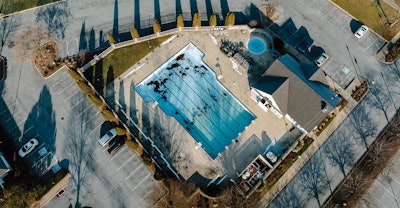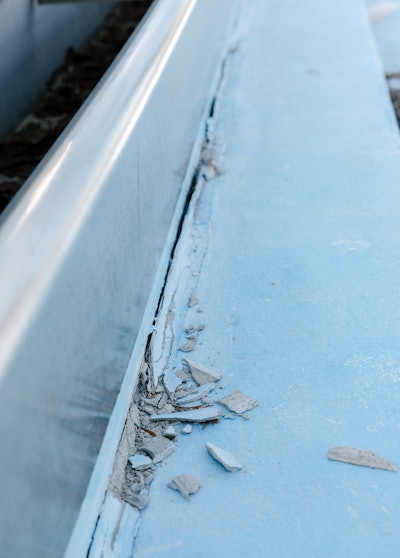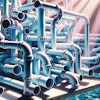
 The beautiful community pool was plagued by a leak that was costing the HOA over $70,000 per year.
The beautiful community pool was plagued by a leak that was costing the HOA over $70,000 per year.
Pool leaks are obviously a problem. Ignoring them creates even bigger problems. The nature of moving water is to expand its pathway, permitting, gradually, an ever-greater volume to pass. This destructive nature in and of itself is an issue, but when water is being purchased, treated and heated, the financial loss increases exponentially.
Unfortunately, as we in the industry know, leaking pools are very common. Many small leaks escape notice, only to devolve into big issues that can't be ignored. Leaks are often caused, or at least exacerbated, by lack of maintenance and improper installation.
A job we're currently working on is a perfect example:
We called a high-end country club in the rolling farm country of Central Pennsylvania to see if they needed help maintaining their 20-year-old, 147,000-gallon seasonal outdoor pool and kiddie pool.
The call struck a chord, because they quickly asked us to visit and look at a pool leak problem they were experiencing. This pool sits at a higher elevation than the adjacent parking lot. We learned that in the summer, maintenance staff are regularly required to pressure wash algae off the parking surface. The algae grows on a large portion of the parking lot that remains wet from water running out of the ground between the pool and the pavement, much like a natural spring.
Ignoring the elephant in the room for a moment, this runoff reduces parking capacity, creates unnecessary maintenance labor, poses a slip-and- fall hazard year-round, and creates an eyesore on an otherwise magnificent property. The water was literally flowing out of the pool, through the soil, and onto the parking lot.
PARTIAL FIX
A number of years ago, the country club had hired a national leak detection company to assist them in determining where the problem originated.
Proper leak detection can be very costly and must be conducted methodically. It's tempting to look for the source of a leak, fix it, and leave, never considering that there may be more than one issue. Property owners, still nursing their wounds from writing the check, assume the problem has been resolved and put their blinders up. After all, it's been fixed, right?
Not always. In the case of aging, improperly maintained pools, multiple leaks are possible, if not likely.
At this country club, 10s of thousands of dollars had been spent to fix the leak, and while the water loss had been somewhat reduced, it had not been stopped, because the reason for the primary leak had never been determined.
 Above and below: It became apparent that the joint between the gutter and the pool shell had become compromised, leading to a severe leak when the pool was full, which then allowed water to run back into the pool from the decking when the water level was low for maintenance.
Above and below: It became apparent that the joint between the gutter and the pool shell had become compromised, leading to a severe leak when the pool was full, which then allowed water to run back into the pool from the decking when the water level was low for maintenance.

FINDING ALL THE ISSUES
Our involvement began in fall of 2022. We met with the property management and gave them an initial price range to come in and conduct leak detection on the gutter pool.
The first thing we did was a simple visual inspection while speaking with maintenance staff to get as much background information as possible. They explained that the pool was losing roughly 6 inches per day, or 15,700 gallons! Following that, we performed a static leak test. This included bringing the water line up close to pool deck level, shutting off the pool's make-up water supply, affixing a measuring stick to the side of the pool, and creating a log form for maintenance staff to record their findings.
The pool level was checked every four hours in order to determine how quickly the water level was falling. It was determined that the body of water was losing a tremendous amount of water within the first 12 hours, followed by more gradual loss afterward. This told us there was a major leak at or near the gutter, and smaller leaks below that.
At that point, we pressure tested all the water lines going to and from the filter room. There was one minor leak in the gutter line, which was the result of a makeshift repair. All other lines were intact.
Next, we conducted a die test of all the main drains and other shell light niches leaked. The pool water was pumped down in order to access the niches, but in doing so, we uncovered another problem.
As water was pumped out of the pool and allowed to spill over the concrete decking to deck drains, we witnessed water running back into the pool below the stainless steel gutter. It appeared as though water was coming from the pool deck drainage system. Further camera work and physical inspection of drainage piping did not reveal any leaks. Pumping was resumed and closer inspection revealed water running into deck expansion joints that had deteriorated and into the permeable subgrade under the deck and adjacent to the pool wall.
This confirmed what maintenance staff had witnessed at times during winter thaws when the pool level was down, and water appeared to flow down the pool wall. After dumping 5 gallons of food coloring onto the deck and spraying down the surface, our fear was confirmed. Yellow food coloring began entering the pool. The pool shell behind the gutter was compromised, but why?
We believe one of two issues is at play. Either the pool was incorrectly installed, or water draining through the deck has saturated the pool wall, and due to winter freeze-thaw cycles over time, has created voids in the pool shell. Possibly a combination of both. Improperly maintained deck joints have allowed water to drain below deck rather than to deck drains. Periods of significant snow or rainfall saturated the subgrade around the pool. When the pool is filled, hydrostatic pressure is on the pool side, but when emptied, hydrostatic pressure is on the backside of the pool wall, forcing entry. The club chose to empty the pool over winter.
We took all of this information to the ownership and provided orders of magnitude for possible repairs vs. full pool replacement.
We've been asked to stem the leaks as much as possible with minor repairs until the end of a shortened swim season, at which point demolition of the pool begins. When demolition takes place, we'll be onsite to examine the exposed pool shell for future reference.
 The added cost of fuel and wear-and-tear on the facility's aging pool heater was yet another expense resulting from the loss of water in the pool.
The added cost of fuel and wear-and-tear on the facility's aging pool heater was yet another expense resulting from the loss of water in the pool.
IN ROUGH NUMBERS
For the country club, the cost of the leaking pool has been tremendous. Ignoring the cost of leak detection, aesthetic damages, maintenance labor, and reduction in parking space, they've been strapped with the expense of buying, treating and heating a staggering volume of makeup water, and now replacing a pool before its time.
During the country club's pool season — a week before Memorial Day through the week after Labor Day — the pool leaked 1,836,900 gallons. The environmental implications are huge.
Currently, the water rate is $3.56 per 1000 gallons, or $6,539.36 in water alone, per season. The losses in chlorine per season are more than $200. Calculating the cost of other treatment chemicals is difficult.
The energy used to heat the lost water is yet another financial and environmental burden, at 15,301,377 BTUs per season. The existing pool heater is roughly 50% efficient, so with a natural gas price of $8.95 per MCF, the true financial loss is $268.61. The total quantifiable cost of the leak throughout the 117-day swimming season is $7,012.71. Over the estimated five-year period that the issue has been present, the leak has cost the club $35,063.55.
Other expenses, including electric, additional chemicals, labor, parking loss, etc., are conservatively just as much, meaning that since the leak began, it has easily cost the club $70,000 over five years.
Keep in mind that the leak has been a problem for more than a decade. The cost of proper leak detection at a pool facility may be high, but the cost of inaction — both financially and environmentally — is much higher.
 When the pool was emptied, water flowing across the damaged concrete decking was found re-entering the pool between the gutter and the shell. A variety of leaks in the pool shell caused nearly 16,000 gallons to flow out of the pool each day, enough to lower the water level by 6 inches every 24 hours.
When the pool was emptied, water flowing across the damaged concrete decking was found re-entering the pool between the gutter and the shell. A variety of leaks in the pool shell caused nearly 16,000 gallons to flow out of the pool each day, enough to lower the water level by 6 inches every 24 hours.








































